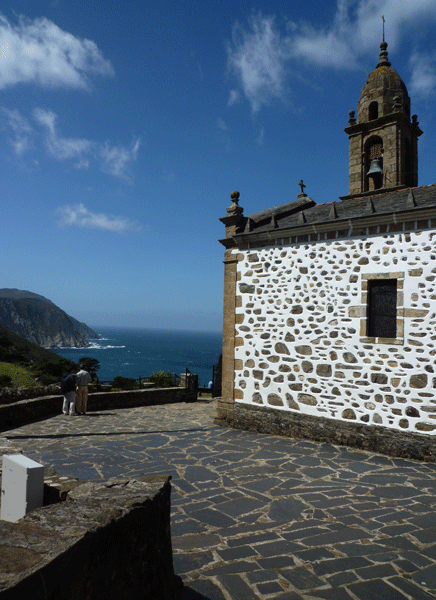words + photos by Elyn Aviva
Souls in the form of lizards and snakes slither their way to the seashore sanctuary of San Andrés de Teixido in northwestern Spain. At least that’s what local Galician folklore claims about this hard-to-reach pilgrimage shrine, perched on a cliff on the Costa da Morte. “If you don’t go there before you die, you’ll have to go there afterwards”—or so the legends assert. So why not go now, I thought to myself? It would certainly be simpler and more convenient. Besides, I was intrigued by these Celtic-tinged stories of transmigration of souls in what appears to be a deeply Catholic country.
 Rather than slither, I went by car, wending my way up and around curvaceous roads shaded by huge eucalyptus trees that swayed in the strong Atlantic breeze. Their medicinal scent filled the air. I pulled over near a TV repeater tower to walk a short stretch of the original pilgrims’ path, careful not to kill any insects I encountered en route—after all, they might be souls on pilgrimage. Or so the legend goes.
Rather than slither, I went by car, wending my way up and around curvaceous roads shaded by huge eucalyptus trees that swayed in the strong Atlantic breeze. Their medicinal scent filled the air. I pulled over near a TV repeater tower to walk a short stretch of the original pilgrims’ path, careful not to kill any insects I encountered en route—after all, they might be souls on pilgrimage. Or so the legend goes.
At last I reached the tiny village of San Andrés and left the car in the large parking lot at the outskirts. I strolled down the narrow lane lined with souvenir stands selling wax ex-votos in the shape of body parts, brightly painted hard-baked bread-dough offerings, and tiny bundles of hierba de enamorar, a local pink flower that is supposed to be a love potion. Something for everyone, I thought. But was there anything here for me?
Around a bend I came to the white-washed sanctuary that guards the relics of the apostle San Andrés (Saint Andrew). The church was surprisingly small, given the size of the folklore that surrounds it. Legend says that San Andrés was distressed because so few pilgrims visited his isolated shrine, so he complained to Christ; Christ felt sorry for him and promised that nobody would enter heaven if they hadn’t gone first to San Andrés de Teixido. It was a great marketing ploy, judging by the popularity of the shrine over the last 400 years.